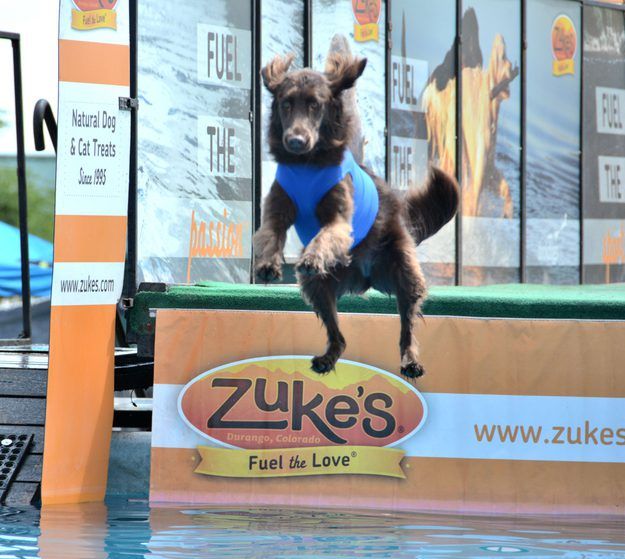Dock-diving competitions were featured at the county fair last week, and I couldn’t get enough. The dogs—so eager to leap, so graceful as they soared through the air, hitting the water with a tremendous splash, and swimming strongly to the toy/lure. Their handlers—serving more as hype men/personal assistants than bosses issuing orders as they escorted the canine athletes to the launching platform, cheered them on, and helped them from the water and wiped them down with towels after their performances. The relationships between them were so heart-warming to see.
Years ago, I had high hopes for participating in this sport with my now-9-year-old dog, Woody. After all, he’s wildly athletic, highly toy-driven, can leap high over my head, and loves to swim! He’d be a natural, I thought!
But it turned out that my high-jumping, strong-swimming dog absolutely hates getting water in his ears! So much so that if you throw his favorite ball into a river or lake, he will race enthusiastically toward the water, and, as he reaches the edge, will always stop and then carefully wade in before he starts strongly swimming toward the toy. And if a wave or splash from another dog causes him to get water in his ears, he will quit the pursuit of his toy and start shaking his head hard as he swims for shore—which only makes more water get in his ears. Leaping into the water is out of the question for Woody; absolutely nothing could compel him to do it.
(Yes, I tried buying a “swimming cap” or swim snood for him—a soft neoprene wrap that is fastened with a Velcro-like material and covers the dog’s ears, keeping water out; he hated it more than getting water in his ears, and would refuse to walk, much less fetch or swim, when he had it on. Most dogs who love swimming or fetching will accept the snood so they can fetch and swim; not my sensitive boy. While this is a great solution for dogs who get ear infections from swimming, it didn’t work for Woody.)
So, years ago, even though it seemed like I had the perfect dog for that sport, and we live near any number of bodies of water where we could practice, I had to give up on the hope of ever participating with him in dock diving. And honestly, that’s fine; it’s not like I bought a puppy with the express hope of competing in dock-diving events.
But lots of people do buy puppies with the express hope of participating in specific activities, from sports such as agility and Ring Sport, to team-based work such as search and rescue or therapy dog visits. And not all the dogs who are selected for these activities turn out to be suitable candidates for those activities! Then what?
Ideally, those owners are able to pivot and find new activities to share with their dogs, because there is nothing sadder than seeing a dog being coerced to participate in an activity that he doesn’t enjoy. One hopes that a trainer or friend will gently suggest a different sport or activity to the dog’s owner, or that the owner sees the joy leaking out of their dog and gets a clue. But it’s difficult to pull the plug on a big investment of time and training and equipment—and even in the social relationships that sport enthusiasts have made with their fellow competitors! If one of your friends has a dog who is clearly not enjoying the work or sport he’s being asked to do, make sure you offer your friend a lot of support for respecting their dog enough to accept the dog’s preference. A forced performance is just sad to see.







Thank you for this article – for so many reasons! I have a dog (Bordoodle) that ‘Only a mother can love’, ‘only I can say bad things about him’, and I jokingly call him a ‘Taker’.
But on the flip side, he is completely loyal, so stunningly handsome, and I love him through everything.
One of the first videos I ever saw of him was when he went to a board and train with two other littermates at 8 weeks of age – transported directly from our breeder to the boarding facility. I am still in touch with both of them (breeder and trainer) and they are insanely wonderful. The video was of Shadow at probably 10 weeks of age showing all three little pups on a low hanging, gently swinging hammock. Two of the other pups jumped off on cue, but it took Shadow a minute to get up the courage to jump down from the 12″ moving object. Okay…….
His anxiety has precluded us from participating in anything. I have a mile long list of things he absolutely hates, or is fearful of, to this day.
He is 6.75 years old. He is a frisbee master (or any flying toys) and I have decided that is his passion in life. He is not affectionate, and I embrace the moments that he chooses to lay by my side, or rarely, on my bed at night for a few moments. I give him morning massages when he wakes up and he does love that (closes his eyes), so I use that for my bonding moments. He is as smart as a whip, completed the Canine Search and Rescue basic training, and excelled. He has a certifiate for instinct testing for herding sheep. Too bad we don’t have sheep in our back yard. He knows so many tricks that I have to write them down so I don’t forget.
Shadow’s littermate, who went to the board and train facility at 8 weeks of age, is a therapy dog. Works with veterans, greets travelers at airports wearing a tutu, and just recently was trained to assist her owner with oncoming migraines. She also excelled at flyball and started agility training.
Shadow has been on anxiety meds for 4 years. Yesterday was his first day without any Rx at all. I weaned him over a month to Calm Chen – a herbal remedy. I had been looking to remove the Rx for quite some time. So far, so good.
I don’t want to list Shadow’s long list of dislikes, fears, etc., because there is no point. I love him dearly, we are joined at the hip, and I wouldn’t have it any other way. <3
Oh, and Shadow has the most gorgeous chestnut eyes, highlighted by his black fur. He will stare into my eyes for 5 minutes? I usually can’t last longer than that. If he could only speak…..
Hi Nancy,
This is so beautifully presented, thank you. In my practice I see a great number of owners who had intended for even something seemingly simple like companionship, only to find their dog doesn’t care and avoids affection. This can be so disheartening for the owner, where no amount of encouragement will budge the dog. We still work on trust, and helping the person accept who their dog is, and where the joy in life is found. (This does not apply, of course, when working with a dog who has shut down, and too nervous to engage. We can craft a gentle plan for that). Sadly, in the show world, if a dog is not suited somehow, they are often re-homed. Anyway, thank you for writing this poignant & important article. I’m going to reference this article in my own IG post about acceptance.
I can relate to this. I rescued a dog looking for an agility prospect. He was a fearful rescue and my enthusiasm and encouragement was not interpreted by him as something good. I went slower, lightened my voice, increased the hands on soothing, took many training breaks, etc. I also tried other activities such as CGC, rally obedience and therapy dog. The only thing he likes is meeting people and getting attention!
I raised a Guide Dog and had to give him up after one year because he was so hyper. Fortunately, he was adopted, has a Lab brother and a happy family with a pool and a big yard.
Letting your dog guide you can make for an interesting journey. When I got my last dog, a Norwich Terrier, I tried introducing her to Agility (no interest), Earthdog (she wanted to make friends with the rats), Lure Coursing (loved it, but only if I would run with her), and finally decided she wasn’t a dog who wanted to do anything. Then nosework came along, and she found her joy. The connection it forged between us is one I will never forget.
I introduced my next (current) dog to nosework, and she was a natural — always air scenting, she excelled at the sport, but found it too slow, she wanted more action. I discovered by accident that she loves agility equipment (a surprise, she’s only 10 lbs and somewhat timid). With trepidation, I found a class for her, and she adores it. It’s been a challenge for me — I am NOT coordinated, and trying to pay attention both to what I’m saying and what my body is doing is really hard for me — but it has enhanced our relationship and now we both love it.
Following your dog’s bliss can make for a far happier journey than trying to make them follow ours.
I have a chocolate Lab male, River, who I expected to continue in the tradition of all my other Labs who loved to fetch, swim (I couldn’t keep them out of water), and just be a Lab. Well, what I got was a GSD wearing Lab clothes. He will MAYBE bring a thrown object back. A good outing he’ll bring it back THREE times!! He does love water, but he’s not a swimmer unless it’s a lake. He’ll sit on pool steps, but that’s it. He likes to “swim” in his large outdoor water bowl…. I had a little black Lab female, True, who would joyfully throw herself off ANYTHING to get to water. This was before the dock diving craze hit but she would have been a natural. By the time it did, she was in her golden years so we started scent work when she was 13. She continued that until her death at 15. Now River is a natural at scent work and we enter scent trials where he excels!! I have so much FUN watching him figure out where the odor is hidden by following the scent cone back. He is very methodical (he has been compared to a GSD during scent trials) and doesn’t bounce around like a mad dog. I love him and wouldn’t change a thing.